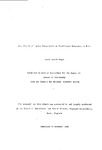The Effects of Lysine Vasopressin on Conditioned Behaviour in Rats
| dc.contributor.author | Hagan, James Joseph | |
| dc.contributor.other | School of Psychology | en_US |
| dc.date.accessioned | 2013-10-28T12:19:01Z | |
| dc.date.available | 2013-10-28T12:19:01Z | |
| dc.date.issued | 1980 | |
| dc.identifier | NOT AVAILABLE | en_US |
| dc.identifier.uri | http://hdl.handle.net/10026.1/2416 | |
| dc.description.abstract |
This thesis is concerned with lysine vasopressin's (LVP's) behavioural activity. Chapter One describes vasopressin's synthesis, secretion, metabolism, pressor, antidiuretic and putative corticotrophic functions with emphasis on behaviourally significant aspects. Chapter Two reviews behavioural data showing that manipulations of endogenous vasopressin levels alter subsequent avoidance performance. Although these data have predominantly been interpreted in favour of vasopressin altering memory formation (consolidation) results reported from an experiment combining response prevention trials and vasopressin injections failed to support the consolidation hypotheis. Chapter Three reviews the response prevention literature and confirms the feasibility of using prevention trials with automated shuttle box training (Experiment One). LVP (1 µg/rat) injected immediately after training increased subsequent extinction responding (Experiment Two). Experiment Three showed that LVP (1 µg/rat) increased responding when injected immediately after prevention trials but decreased extinction responding when injected after 30 minutes of post training retention in the home cage or 30 extinction trials. LVP injections 30 minutes after training and immediately after prevention trials increased suppression of concurrent lever press responding 24 hours later (Experiment Four). Manipulating the training-injection interval after automated training yielded maximal response reductions with a 60 minute interval (Experiment Five) with indications of a negative dose response curve for higher (2-4 µg/rat) doses (Experiment Six). Manual shuttle box tests showed that with a 30 minute training-injection interval subsequent extinction responding varied as an inverted "U" shaped function of the LVP dose (Experiment Seven). Opposite effects of 0.11 µg/rat and 2.97 µg/rat were confirmed with higher training shock levels (Experiment Nine). A further experiment (Experiment Eight) revealed a complex interaction between dose and injection interval. Extinction responding was also reduced by some doses of DG-LVP (Experiment Ten). Post training manipulation of cholinergic activity did not alter LVP's response reducing effects in well trained rats (Experiment Eleven) although some cholinergic involvement was indicated (Experiment Fourteen) in the response increasing effects of LVP (1 µg/rat) injected 30 minutes after training in poor avoidance learners (Experiments Twelve and Thirteen). Tests on the suitability of appetitive responding for exploring vasopressin's behavioural effects showed that both a variable interval (60 seconds) schedule and differential reinforcement of low response rates (DRL) schedule were sensitive to high LVP doses (3-4 µg/rat). The implications of these data for our understanding of vasopressin's behavioural effects are discussed. | en_US |
| dc.language.iso | en | en_US |
| dc.publisher | University of Plymouth | en_US |
| dc.title | The Effects of Lysine Vasopressin on Conditioned Behaviour in Rats | en_US |
| dc.type | Thesis | |
| dc.identifier.doi | http://dx.doi.org/10.24382/4597 | |
| dc.identifier.doi | http://dx.doi.org/10.24382/4597 |
Files in this item
This item appears in the following Collection(s)
-
01 Research Theses Main Collection
Research Theses Main


